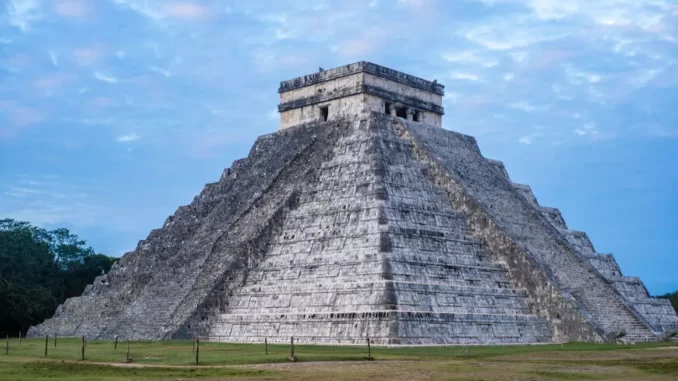
The Mayan Civilization developed in the Mesoamerican region and reached its peak between 250 AD and 900 AD, beginning its decline after this period.
The Mayans formed a civilization that was developed in the region known as Mesoamerica and was located in Central America, for the most part, and North America, only in part of the territory in which Mexico is located today.
The Mayan civilization had its main centers located in Guatemala and Mexico, but traces of this civilization have also been found in El Salvador, Belize, Honduras, etc. They are known to be a pre-Columbian civilization and also a Mesoamerican civilization.
Religion
The first relevant information about the Mayan religion is that they believed in more than one god, therefore, they were polytheists . They, like other Mesoamerican peoples, considered that their gods lived in a place called Tamoanchan , a mythological paradise.
These people believed that events in the natural world were governed by spiritual forces and the power of the ancestors . Furthermore, nature sites were thought to be sacred places. Caves, for example, were seen as doors to the supernatural world and were places in which a series of rituals were performed.
Within Mayan religion, it was believed that human sacrifices were important to ensure that the gods were satisfied and guaranteed the functioning of the universe. These people used to sacrifice prisoners of war and people who voluntarily gave themselves to sacrifice. Archaeologist Nicholas J. Saunders states that the rulers of this society organized militias with the sole purpose of imprisoning great warriors from neighboring cities to sacrifice them |1| .
The sacrifices took place in very violent rituals and the most common forms of sacrifice were decapitation and the removal of the heart while the person was alive. Mayan religious ceremonies were also marked by the consumption of hallucinogenic substances. One of the hallucinogenic drinks was balche , composed of an alcoholic drink made from honey, tree bark and hallucinogenic mushrooms |2| . Trance rituals, in turn, were restricted to the elite of society.
Some of the Mayan gods that can be mentioned are Itzamná , the creator god of the Universe; Ix Chel , the rainbow lady; Kinich Ahau deus Sol, among others. Many other gods Hunab Ku and Chac were understood as other manifestations of Itzamná
Society and culture
The Mayans had a hierarchical society , that is, divided into very well-defined social groups, each with distinct functions. The most numerous group in society were the peasants , those responsible for agriculture and supplying their city. The elite were responsible for the administration of city-states and religious functions. The highest authority and top of the Mayan social pyramid was the king of each city, called the ajaw .
The Mayans saw the world as a place that operated cyclically, that is, in cycles of phases that would repeat forever. Within this vision, they had a double calendar system in which one was made up of 365 days (called Haab ) and the other was made up of 260 (it was called Tzolkin ).
They believed that the Earth was flat and that it had four sacred directions, each having a respective color. They used drawings of animals to represent their philosophical ideas and other areas of knowledge, such as Astronomy.
The Mayans never formed an empire proper, like the Incas and Aztecs , because their political organization was based on the idea of city-states . In other words, each city was an independent administrative entity, with its own authorities and borders that were established by the limits of the city itself. In the case of the Mayan civilization, its zone of occupation is considered to be the regions that were under Mayan influence.
The Mayan city-states traded with each other, but historians and archaeologists have also proven that they waged war against each other. These wars happened because certain cities always tried to impose their dominance over neighboring cities. Throughout Mayan history, some cities managed to impose a certain regional dominance. Among the prominent cities we can mention Palenque , Tikal and Calakmul . The city of Chichen Itzá is considered by some historians as a city of mixed Toltec and Mayan culture.
As already explained, the king, called ajaw by the Mayans , was the highest authority in the city and was seen by his subjects as a manifestation of the gods. Royal power was transmitted patrilineally, that is, it followed the father’s lineage. Despite this patrilineal lineage, the throne could be occupied by a woman in the following situations: when the appointed king was not old enough or if he was fighting in war.
Human sacrifices played an important role in Mayan politics. The aforementioned militias formed by the king to imprison warriors from neighboring cities to sacrifice them were mainly aimed at high-level warriors and rulers. This is because capturing well-known warriors from other cities brought great prestige to the king responsible for the capture.
Mayan decline
The Mayan civilization reached its peak during the period between 250 AD and 900 AD. After this period, historians point out that the decadence that led to their disappearance began. This period of decline is known as the Postclassic Period . The reasons for this decline are still studied by historians, who currently point out the main causes: the lack of food resulting from overpopulation and land depletion, natural disasters, diseases, in addition to wars.
During the weakening of the Mayan civilization, some places drastically lost a large number of inhabitants. These people moved to other places in Mesoamerica in search of better living conditions. As a result, a large part of the Mayan cities were abandoned and, when Europeans arrived in Mesoamerica, they found these cities completely or partially empty.